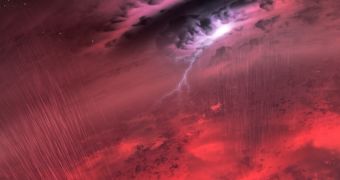According to the conclusions of a new scientific study led by University of Western Ontario expert Stanimir Metchev, it would appear that most brown dwarfs in the Universe feature at least one atmospheric disturbance similar to the Great Red Spot on Jupiter.
Brown dwarfs, also known as failed stars, are objects much larger than gas giants, but smaller than actual stars. They are unable to conduct nuclear fusion, since their formation processes were interrupted before the cloud of molecular hydrogen from which they collapsed could ignite.
The Great Red Spot is a massive storm in Jupiter's southern hemisphere, composed of a persistent anticyclone. Gian Domenico Cassini, for whom the NASA Cassini probe around Saturn is named, was the first to observe this feature, between 1665 and 1713.
According to some researchers, the storm has been raging in the Jovian atmosphere for 184 years. Other astronomers say that the event may have begun unfolding nearly 350 years ago. The debate on the age of the GRS is still ongoing in the international astronomical community.
The new investigation, based on data collected by the NASA Spitzer Space Telescope, suggests that most brown dwarfs feature at least one or two swirling storms such as the GRS in their atmospheres.
“As the brown dwarfs spin on their axis, the alternation of what we think are cloud-free and cloudy regions produces a periodic brightness variation that we can observe. These are signs of patchiness in the cloud cover,” Metchev said.
Details of the investigation were presented by Stony Brook University investigator and study team member Aren Heinze, at the 223rd annual meeting of the American Astronomical Society (AAS), held in Washington DC.
Heinze said that, most likely, the GRS-like features on brown dwarfs resemble torrential rains, and come packed with intense winds and extreme lightning. Since these objects are very hot, the rain most likely does not contain water, but rather molten iron, salts or sand.
After studying a sample of 44 brown dwarfs, the research group was able to determine that more than half of these objects displayed the brightness variations associated with massive storms. Before the study began, scientists predicted that only a small sample of the study population would showcase these signs.
Furthermore, many of the brown dwarfs were spinning around their axis in a way that would make any potential storms invisible from our vantage point here on Earth. This implies that most, if not all, brown dwarfs have at least one GRS-like feature in their atmosphere.
“We needed Spitzer to do this. Spitzer is in space, above the thermal glow of the Earth's atmosphere, and it has the sensitivity required to see variations in the brown dwarfs' brightness,” Metchev explains.
The telescope was used to analyze each of the celestial orbs for at least 20 hours. This prolonged exposure time helped the team discover that a percentage of the brown dwarfs rotates around their axi a lot slower than previous studies led astronomers to believe.
In theory, these objects should start to spin very fast as they collapse from their hydrogen clouds, and then maintain this speed throughout their life span. “We don't yet know why these particular brown dwarfs spin so slowly, but several interesting possibilities exist,” Heinze said at the AAS meeting today.
“A brown dwarf that rotates slowly may have formed in an unusual way – or it may even have been slowed down by the gravity of a yet-undiscovered planet in a close orbit around it,” he added.
Studies such as this one could lead not only to a better understanding of brown dwarfs, but to new knowledge about gas giants and exoplanetary weather patterns as well. However, it is very difficult to study regular exoplanets since they usually orbit very close to their parent stars. This make brown dwarfs the perfect space weather laboratories.

 14 DAY TRIAL //
14 DAY TRIAL //